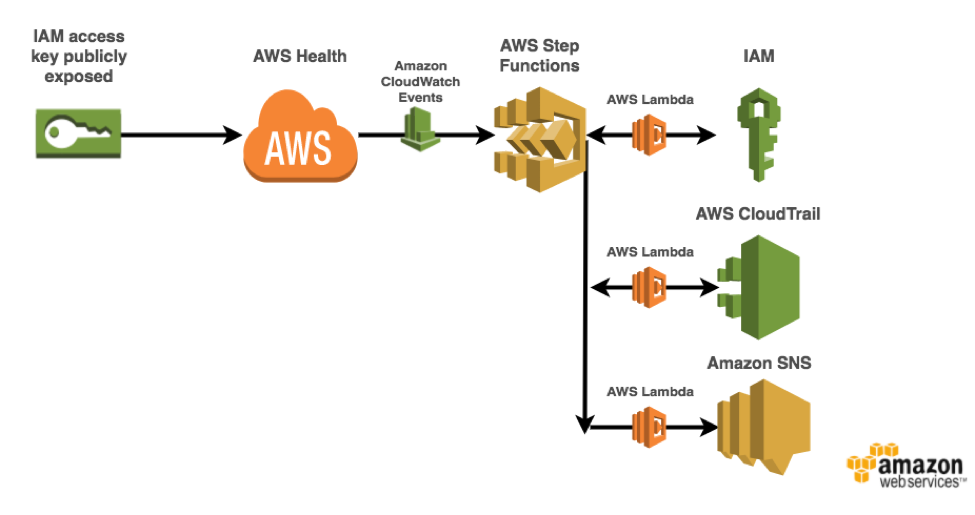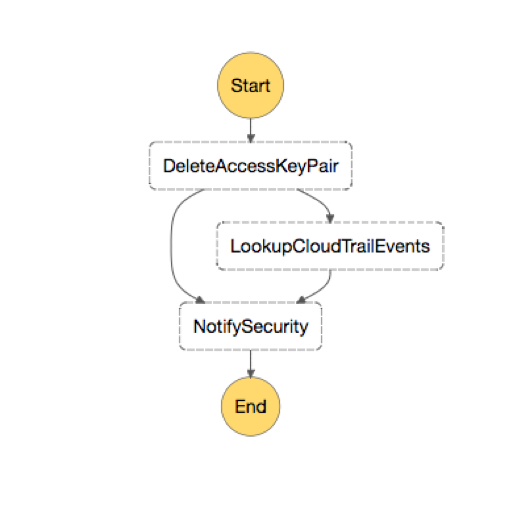AWS Compute Blog
Automate Your IT Operations Using AWS Step Functions and Amazon CloudWatch Events

Rob Percival, Associate Solutions Architect
Are you interested in reducing the operational overhead of your AWS Cloud infrastructure? One way to achieve this is to automate the response to operational events for resources in your AWS account.
Amazon CloudWatch Events provides a near real-time stream of system events that describe the changes and notifications for your AWS resources. From this stream, you can create rules to route specific events to AWS Step Functions, AWS Lambda, and other AWS services for further processing and automated actions.
In this post, learn how you can use Step Functions to orchestrate serverless IT automation workflows in response to CloudWatch events sourced from AWS Health, a service that monitors and generates events for your AWS resources. As a real-world example, I show automating the response to a scenario where an IAM user access key has been exposed.
Serverless workflows with Step Functions and Lambda
Step Functions makes it easy to develop and orchestrate components of operational response automation using visual workflows. Building automation workflows from individual Lambda functions that perform discrete tasks lets you develop, test, and modify the components of your workflow quickly and seamlessly. As serverless services, Step Functions and Lambda also provide the benefits of more productive development, reduced operational overhead, and no costs incurred outside of when the workflows are actively executing.
Example workflow
As an example, this post focuses on automating the response to an event generated by AWS Health when an IAM access key has been publicly exposed on GitHub. This is a diagram of the automation workflow:
AWS proactively monitors popular code repository sites for IAM access keys that have been publicly exposed. Upon detection of an exposed IAM access key, AWS Health generates an AWS_RISK_CREDENTIALS_EXPOSED event in the AWS account related to the exposed key. A configured CloudWatch Events rule detects this event and invokes a Step Functions state machine. The state machine then orchestrates the automated workflow that deletes the exposed IAM access key, summarizes the recent API activity for the exposed key, and sends the summary message to an Amazon SNS topic to notify the subscribers―in that order.
The corresponding Step Functions state machine diagram of this automation workflow can be seen below:
While this particular example focuses on IT automation workflows in response to the AWS_RISK_CREDENTIALS_EXPOSEDevent sourced from AWS Health, it can be generalized to integrate with other events from these services, other event-generating AWS services, and even run on a time-based schedule.
Walkthrough
To follow along, use the code and resources found in the aws-health-tools GitHub repo. The code and resources include an AWS CloudFormation template, in addition to instructions on how to use it.
The Step Functions state machine execution starts with the exposed keys event details in JSON, a sanitized example of which is provided below:
{
"version": "0",
"id": "121345678-1234-1234-1234-123456789012",
"detail-type": "AWS Health Event",
"source": "aws.health",
"account": "123456789012",
"time": "2016-06-05T06:27:57Z",
"region": "us-east-1",
"resources": [],
"detail": {
"eventArn": "arn:aws:health:us-east-1::event/AWS_RISK_CREDENTIALS_EXPOSED_XXXXXXXXXXXXXXXXX",
"service": "RISK",
"eventTypeCode": "AWS_RISK_CREDENTIALS_EXPOSED",
"eventTypeCategory": "issue",
"startTime": "Sat, 05 Jun 2016 15:10:09 GMT",
"eventDescription": [
{
"language": "en_US",
"latestDescription": "A description of the event is provided here"
}
],
"affectedEntities": [
{
"entityValue": "ACCESS_KEY_ID_HERE"
}
]
}
}After it’s invoked, the state machine execution proceeds as follows.
Step 1: Delete the exposed IAM access key pair
The first thing you want to do when you determine that an IAM access key has been exposed is to delete the key pair so that it can no longer be used to make API calls. This Step Functions task state deletes the exposed access key pair detailed in the incoming event, and retrieves the IAM user associated with the key to look up API activity for the user in the next step. The user name, access key, and other details about the event are passed to the next step as JSON.
This state contains a powerful error-handling feature offered by Step Functions task states called a catch configuration. Catch configurations allow you to reroute and continue state machine invocation at new states depending on potential errors that occur in your task function. In this case, the catch configuration skips to Step 3. It immediately notifies your security team that errors were raised in the task function of this step (Step 1), when attempting to look up the corresponding IAM user for a key or delete the user’s access key.
Note: Step Functions also offers a retry configuration for when you would rather retry a task function that failed due to error, with the option to specify an increasing time interval between attempts and a maximum number of attempts.
Step 2: Summarize recent API activity for key
After you have deleted the access key pair, you’ll want to have some immediate insight into whether it was used for malicious activity in your account. Another task state, this step uses AWS CloudTrail to look up and summarize the most recent API activity for the IAM user associated with the exposed key. The summary is in the form of counts for each API call made and resource type and name affected. This summary information is then passed to the next step as JSON. This step requires information that you obtained in Step 1. Step Functions ensures the successful completion of Step 1 before moving to Step 2.
Step 3: Notify security
The summary information gathered in the last step can provide immediate insight into any malicious activity on your account made by the exposed key. To determine this and further secure your account if necessary, you must notify your security team with the gathered summary information.
This final task state generates an email message providing in-depth detail about the event using the API activity summary, and publishes the message to an SNS topic subscribed to by the members of your security team.
If the catch configuration of the task state in Step 1 was triggered, then the security notification email instead directs your security team to log in to the console and navigate to the Personal Health Dashboard to view more details on the incident.
Lessons learned
When implementing this use case with Step Functions and Lambda, consider the following:
- One of the most important parts of implementing automation in response to operational events is to ensure visibility into the response and resolution actions is retained. Step Functions and Lambda enable you to orchestrate your granular response and resolution actions that provides direct visibility into the state of the automation workflow.
- This basic workflow currently executes these steps serially with a catch configuration for error handling. More sophisticated workflows can leverage the parallel execution, branching logic, and time delay functionality provided by Step Functions.
- Catch and retry configurations for task states allow for orchestrating reliable workflows while maintaining the granularity of each Lambda function. Without leveraging a catch configuration in Step 1, you would have had to duplicate code from the function in Step 3 to ensure that your security team was notified on failure to delete the access key.
- Step Functions and Lambda are serverless services, so there is no cost for these services when they are not running. Because this IT automation workflow only runs when an IAM access key is exposed for this account (which is hopefully rare!), the total monthly cost for this workflow is essentially $0.
Conclusion
Automating the response to operational events for resources in your AWS account can free up the valuable time of your engineers. Step Functions and Lambda enable granular IT automation workflows to achieve this result while gaining direct visibility into the orchestration and state of the automation.
For more examples of how to use Step Functions to automate the operations of your AWS resources, or if you’d like to see how Step Functions can be used to build and orchestrate serverless applications, visit Getting Started on the Step Functions website.


